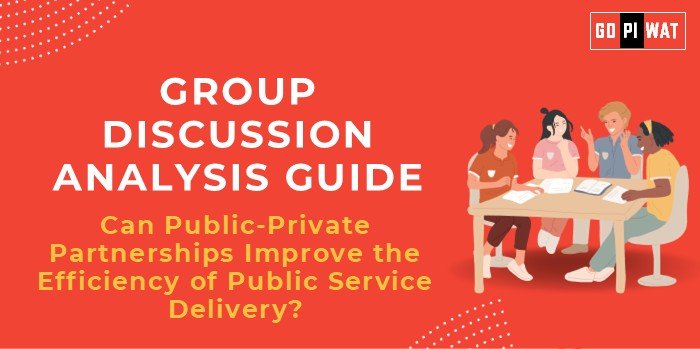📋 Group Discussion (GD) Analysis Guide: Can Public-Private Partnerships Improve the Efficiency of Public Service Delivery?
🌟 Introduction to the Topic
Across the globe, public-private partnerships (PPPs) have been pivotal in advancing infrastructure, health, and education services. In India, with increasing demands for efficiency in public service delivery, PPPs emerge as a promising model to bridge gaps in resources, expertise, and implementation.
The concept of PPPs involves collaboration between government bodies and private entities to deliver public goods or services efficiently. India has a robust history with PPPs, such as in roadways (Golden Quadrilateral) and renewable energy (Rewa Solar Project), but their broader application to public services is still evolving.
📊 Quick Facts and Key Statistics
- 🏗️ PPP Projects: India ranks second globally in PPP projects, with over 1,200 in operation.
- 🏥 Healthcare: 25% of Ayushman Bharat empaneled hospitals are private facilities, reflecting PPP’s role in health access.
- 💰 Infrastructure Investment: $1.4 trillion investment under National Infrastructure Pipeline (2019-2025), leveraging PPP models.
- 📉 Efficiency Gains: PPP projects are, on average, 20-30% more cost-effective than traditional public sector-led projects (World Bank, 2023).
👥 Stakeholders and Their Roles
- 📜 Government: Policy formulation, regulatory oversight, and resource allocation.
- 🏢 Private Sector: Investment, technology infusion, and project management expertise.
- 👩👩👦👦 Citizens: End-users benefiting from improved services.
- 🌍 International Organizations: Funding and technical expertise (e.g., World Bank, ADB).
✅ Achievements and Challenges
🏆 Achievements:
- 🚇 Infrastructure Development: The Delhi Metro (DMRC) is a global PPP success story.
- 🏥 Healthcare Access: Ayushman Bharat’s collaboration with private hospitals.
- 🎓 Education: Model schools under PPP frameworks in states like Rajasthan.
⚠️ Challenges:
- ⚖️ Regulatory Uncertainty: Policy changes impacting long-term projects.
- 💰 Profit vs. Public Interest: Balancing private profits with equitable access.
- 🏗️ Execution Delays: Issues in land acquisition and bureaucratic hurdles.
🌍 Global Comparisons
- 🇬🇧 United Kingdom: The NHS PPP model has enhanced healthcare efficiency.
- 🇸🇬 Singapore: Efficient urban development through PPPs.
📌 Structured Arguments for Discussion
- 🔹 Supporting Stance: “PPPs enhance resource efficiency and technological infusion, evidenced by India’s highway expansion projects.”
- 🔹 Opposing Stance: “The profit-driven motives in PPPs often neglect equitable access, as seen in some privatized education initiatives.”
- 🔹 Balanced Perspective: “While PPPs bring expertise, robust regulation is essential to align private interests with public welfare.”
🔍 Effective Discussion Approaches
- 📈 Opening Approaches:
- “India’s 1,200 PPP projects showcase the potential of collaboration in public service efficiency.”
- “While PPPs promise innovation, challenges like profit motives pose ethical dilemmas.”
- 🔄 Counter-Argument Handling:
- “While profit motives exist, regulatory frameworks like hybrid annuity models mitigate risks.”
📈 Strategic Analysis of Strengths and Weaknesses
- ✅ Strengths: Resource mobilization, innovation, risk-sharing.
- ⚠️ Weaknesses: Regulatory gaps, dependence on private sector priorities.
- 🌟 Opportunities: Smart cities, green energy.
- ⚡ Threats: Public resistance, potential monopolies.
🎓 Connecting with B-School Applications
- 💡 Real-World Applications:
- Finance: Risk assessment in PPP models.
- Operations: Managing large-scale collaborations.
- Policy: Designing inclusive PPP frameworks.
- 💬 Sample Interview Questions:
- “How do PPPs balance efficiency with equity?”
- “Discuss a successful PPP project in India.”
- 📘 Insights for B-School Students:
- “PPPs require interdisciplinary knowledge, combining economics, management, and policy insights.”


